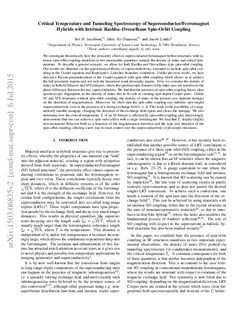| dc.description.abstract | We investigate theoretically how the proximity effect in superconductor/ferromagnet hybrid structures with intrinsic spin-orbit coupling manifests in two measurable quantities, namely the density of states and critical temperature. To describe a general scenario, we allow for both Rashba and Dresselhaus type spin-orbit coupling. Our results are obtained via the quasiclassical theory of superconductivity, extended to include spin-orbit coupling in the Usadel equation and Kupriyanov–Lukichev boundary conditions. Unlike previous works, we have derived a Riccati parametrization of the Usadel equation with spin-orbit coupling which allows us to address the full proximity regime and not only the linearized weak proximity regime. First, we consider the density of states in both SF bilayers and SFS trilayers, where the spectroscopic features in the latter case are sensitive to the phase difference between the two superconductors. We find that the presence of spin-orbit coupling leaves clear spectroscopic fingerprints in the density of states due to its role in creating spin-triplet Cooper pairs. Unlike SF and SFS structures without spin-orbit coupling, the density of states in the present case depends strongly on the direction of magnetization. Moreover, we show that the spin-orbit coupling can stabilize spin-singlet superconductivity even in the presence of a strong exchange field h ∆. This leads to the possibility of a magnetically tunable minigap: changing the direction of the exchange field opens and closes the minigap. We also determine how the critical temperature Tc of an SF bilayer is affected by spin-orbit coupling and, interestingly, demonstrate that one can achieve a spin-valve effect with a single ferromagnet. We find that Tc displays highly non-monotonic behavior both as a function of the magnetization direction and the type and direction of the spin-orbit coupling, offering a new way to exert control over the superconductivity of proximity structures. | nb_NO |
